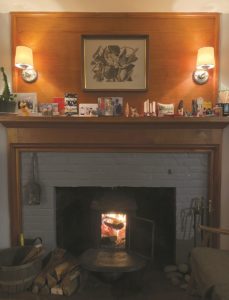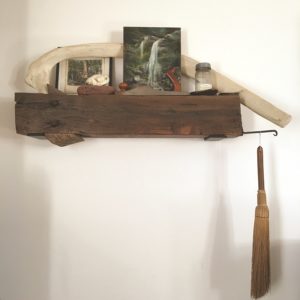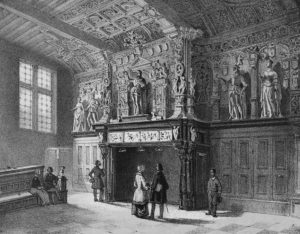“The fact that ‘hearth’ is synonymous with ‘home’ in so many tongues is sufficient argument for a fireplace,” writes Bradford Angier in his 1952 book How to Build Your Home in the Woods.
Around the 12th century, the hearth took up a new position in the home. What was once a simple pit in the center of the room began to be built into exterior walls. While the chimney had a practical purpose — to vent smoke up and outdoors — its jamb, the chimneypiece or mantelpiece, evolved to become one of the most ornamental parts of a room, sometimes extending up the wall to the ceiling.
Whether a mantel is truly beautiful depends not only on its design but on how it is used. Brad Angier prefaced his instructions for do-it-yourself home builders with this complaint on that subject: “If there is to be a mantel (and more homes than might be expected could do well without what too often becomes an unsightly dust collector)….”

The 1964 mantel in my Eastham home sits over a vintage wood stove insert we added in 2014. I try to revisit, every month or so, what’s on display there. That seasonal reconsideration helps keep it from collecting dust, bills, keys, and the detritus of everyday life. (Photo Milisa Moses)

This photo suggests a totally different direction — a mantel that is more symbolic than real. It is the creation of Dean Moran, a Wellfleet builder, artist, and WOMR DJ. Made from a slab of found wood, his mantle is free-floating on a wall near the woodstove. It is too small to be a catch-all. It is just right, though, for holding a carefully assembled vignette of artwork and objects that both Dean and his partner Sara Moran change from time to time, when something comes along that they want to highlight there. Right now, a vintage plane sits in front of a small painting, alongside a homemade candle, beach rocks, and driftwood. A handmade broom hangs on the side. (Photo Dean Moran)

The timber, marble, and alabaster mantelpiece at the Mansion of the Brugse Vrije in Bruges, Belgium was designed by Lanceloot Blondeel in 1528.



